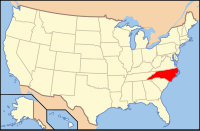Sampson County, NC
| Sampson County, North Carolina | ||
|---|---|---|

Sampson County Courthouse in Clinton (circa 1910–1915)
|
||
|
||
 Location in the U.S. state of North Carolina |
||
 North Carolina's location in the U.S. |
||
| Founded | 1784 | |
| Named for | John Sampson | |
| Seat | Clinton | |
| Largest city | Clinton | |
| Area | ||
| • Total | 962 sq mi (2,492 km2) | |
| • Land | 960 sq mi (2,486 km2) | |
| • Water | 2 sq mi (5 km2), 0.2% | |
| Population | ||
| • (2010) | 63,431 | |
| • Density | 67/sq mi (26/km²) | |
| Congressional district | 7th | |
| Time zone | Eastern: UTC-5/-4 | |
| Website | www |
|
Sampson County is the largest county in North Carolina. As of the 2010 Census, the population was 63,431. Its county seat is Clinton.
Sampson County was formally and legally established in April 1784 by the North Carolina General Assembly from an area taken from neighboring Duplin County. Land from neighboring Wayne County and New Hanover counties would be annexed later.
The early settlers were Scotch-Irish immigrants from North Ireland, many of who came to the colony of North Carolina under the protection and inducements of Henry McCulloch, a wealthy London merchant. The community of Taylors Bridge, located about halfway between Clinton and Harrells in lower Sampson County (at the time Duplin County), was one of the earliest European settled areas of the county, with pioneer families living there as early as the 1730s or 1740s. The first settlers of the area were Edmond Matthis, William Johnson, William Robinson and John Register, followed by members of the Peterson, Knowles, Vann, Boney, Merritt, Pearson, Powell, Herring, Rogers, Bryant, Ezzell, James Murphy, Ward, Sellers, Parrish, Fryar, Williamson and Bass families. In 1745, McCullough had obtained grants from the British Crown covering some 71,160 acres of land "lying and situated on the branches of the North East and Black River." The Scotch-Irish immigrants were soon joined by descendants of the Swiss colony in New Bern, and sometime later, pioneers from the northern states of New Jersey, Connecticut and Massachusetts.
Among these first European Settlers of the area was John Sampson. Sampson was the first register of deeds of Duplin County. He served as a Lt. Colonel, and then a Lt. General in the county’s militia and was later the first mayor of Wilmington, North Carolina. John Sampson brought along who is thought to be his step-son Richard Clinton. Like his stepfather, Richard Clinton soon distinguished himself in governmental and military service, serving as Duplin County’s Register of Deeds for ten years, and then in the Provincial Congress held at Hillsboro. In 1776, Richard Clinton organized a company of militia minutemen from upper Duplin County and led them as captain in the defense of Wilmington against the British. He was later appointed Colonel of Cavalry and Brigadier General of the Fayetteville District. Upon the establishment of the state government of North Carolina by the Halifax Constitution of 1776, Richard Clinton served as one of the first members of the House of Commons, representing the County of Duplin as a House member while his brother-in-law James Kenan served in the Senate . Clinton continued as a representative of Duplin County until the creation of Sampson County in 1784. Clinton secured the passage of the act creating the new county, and proposed the name "Sampson" in honor of John Sampson, his stepfather and benefactor.
...
Wikipedia

